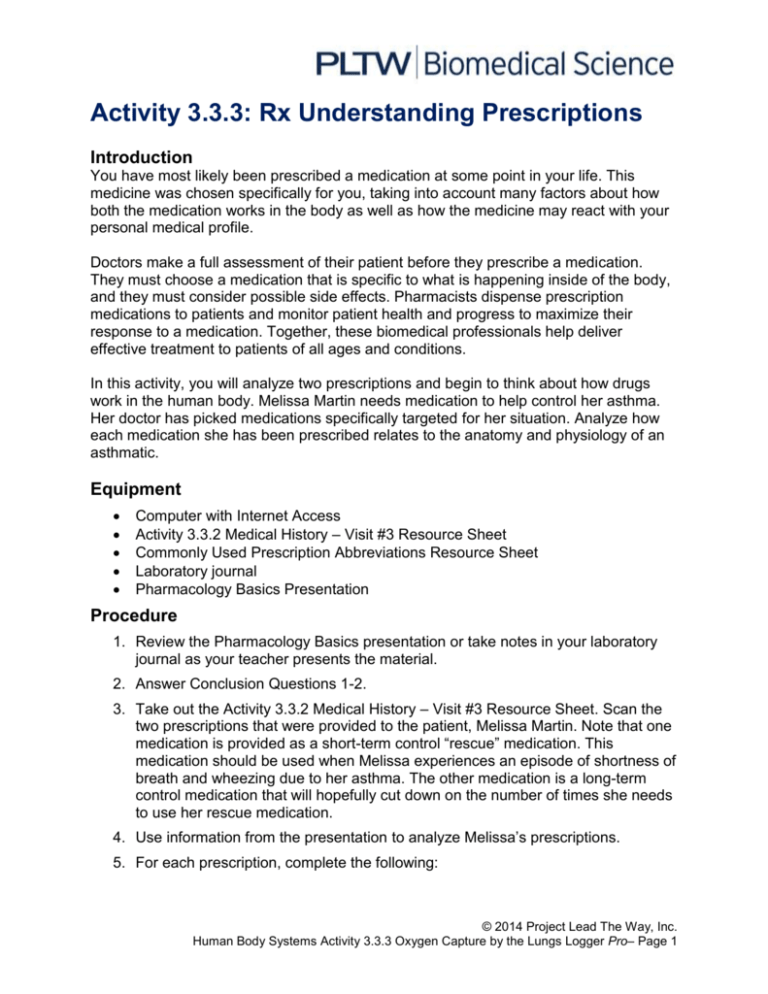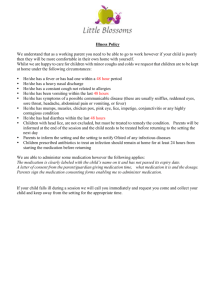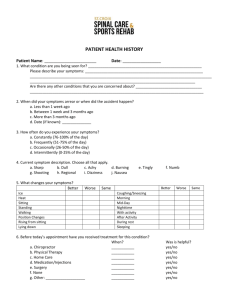3.3.3 PharmaBasics - Project Lead the Way: Biomedical Sciences
advertisement

Activity 3.3.3: Rx Understanding Prescriptions Introduction You have most likely been prescribed a medication at some point in your life. This medicine was chosen specifically for you, taking into account many factors about how both the medication works in the body as well as how the medicine may react with your personal medical profile. Doctors make a full assessment of their patient before they prescribe a medication. They must choose a medication that is specific to what is happening inside of the body, and they must consider possible side effects. Pharmacists dispense prescription medications to patients and monitor patient health and progress to maximize their response to a medication. Together, these biomedical professionals help deliver effective treatment to patients of all ages and conditions. In this activity, you will analyze two prescriptions and begin to think about how drugs work in the human body. Melissa Martin needs medication to help control her asthma. Her doctor has picked medications specifically targeted for her situation. Analyze how each medication she has been prescribed relates to the anatomy and physiology of an asthmatic. Equipment Computer with Internet Access Activity 3.3.2 Medical History – Visit #3 Resource Sheet Commonly Used Prescription Abbreviations Resource Sheet Laboratory journal Pharmacology Basics Presentation Procedure 1. Review the Pharmacology Basics presentation or take notes in your laboratory journal as your teacher presents the material. 2. Answer Conclusion Questions 1-2. 3. Take out the Activity 3.3.2 Medical History – Visit #3 Resource Sheet. Scan the two prescriptions that were provided to the patient, Melissa Martin. Note that one medication is provided as a short-term control “rescue” medication. This medication should be used when Melissa experiences an episode of shortness of breath and wheezing due to her asthma. The other medication is a long-term control medication that will hopefully cut down on the number of times she needs to use her rescue medication. 4. Use information from the presentation to analyze Melissa’s prescriptions. 5. For each prescription, complete the following: © 2014 Project Lead The Way, Inc. Human Body Systems Activity 3.3.3 Oxygen Capture by the Lungs Logger Pro– Page 1 Determine whether the name of the medication is the generic name or a brand name. If it is a brand name, write the generic name of the medication on the prescription Describe in simple terms how and when Melissa is to take this medication. Provide a key that explains each prescription abbreviation. Research how each of the drugs works to help treat and control asthma. Take notes in your laboratory journal. Determine which medication is the “rescue” medication and which is the long-term control medication. Write “RESCUE” and “CONTROL” at the top of the appropriate prescription to help Melissa remember which is which. Write a 1-2 sentence description of how each medication works in the Medications section of the Medical History Resource Sheet. Research the most common side effects of each medication. Add a paragraph in the Medications section of the Medical History Resource Sheet that lists these side effects and alerts Melissa to when she should seek medical attention regarding any reaction to the drugs. 6. Answer the remaining Conclusion questions. Conclusion Questions 1. In an emergency situation, why is a drug most commonly delivered via injection versus an oral route? 2. Why is it important that a pharmacist knows each medication that a person is taking before they provide a new drug? © 2014 Project Lead The Way, Inc. Human Body Systems Activity 3.3.3 Oxygen Capture by the Lungs Logger Pro– Page 2 3. Describe how albuterol provides relief to asthma patients. Refer to relevant respiratory anatomy as well as the changes that occur in the airways of an asthmatic. 4. Describe how Accolate® helps control asthma. Refer to relevant respiratory anatomy as well as the changes that occur in the airways of an asthmatic. 5. Why do you think Melissa is instructed to use the albuterol inhaler prior to exercise and before she ever has any symptoms? 6. Why is it important for Melissa to have a follow-up with her physician after she begins using these medications? © 2014 Project Lead The Way, Inc. Human Body Systems Activity 3.3.3 Oxygen Capture by the Lungs Logger Pro– Page 3




